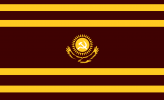A set of flags for an ATL federalized Kingdom of Yugoslavia.
Croatia and Slovenia shouldn't need much explanation, Vardaria (OTL Macedonia, the name is avoided to avoid connections with the IMRO and claims on Greek land) uses the "Macedonian" COA from the Illyrian armorials that also forms the basis of a modern proposal for a new Macedonian COA. The Illyrian Armorials, though partly fictional, were and continue to be very influential on Balkan and Hungarian heraldry. The colors roughly represent the blue waters of the Vardar as well as prosperity, the bright sun that shines over the country as well as the mineral wealth of the highlands, and the green stands for the extreme fertility of the Vardar valley.
The Banovinas that didn't get any kind of special autonomy, formally called the Federal Banovinas, are basically a greater Serbia and have collectively been referred to as Serbia colloquially especially after Slovenia was elevated to the same status as Croatia and Vardaria (as opposed to being a "special federal Banovina" with some autonomy but less than the autonomous ones).
The old Banovina borders, rather than ones based on historic and cultural regions, were retained despite the development of "organic Yugoslavism" which accepts the existence of regional sub-identities within the overarching Yugoslav one, not out of any ideological reason but out of pragmatism. It would've been expensive and complicated to redraw the borders and the pre-existing ones have the advantage of gerrymandering each federal Banovina into being Orthodox Serb-majority (as opposed to having any Hungarian, Albanian, or most importantly Bosniak or, as the government would say Muslim Serb and Muslim Croat, majority areas). The banovinas did, however, adopt historic and regional symbols to the best of their abilities.
- Vrbas (Bosnian Krajina) lacks any clear heraldic symbols due both to the late arrival of heraldry and the fact that Donji Kraj was generally ruled by nobles from other regions and thus had no unique arms associated with itself. Thus, a common local animal, the badger, was chosen. Its featuring in local Serb author Petar Kočić's anti-Austrian satire "The Badger in Court" as a victim of Austrian tyranny didn't hurt the badger's chances of being chosen. The green and blue represent the tree-covered hills and many rivers of the Banovina.
- The Drina Banovina uses the arms of the Vojinović coat of arms (or at least the arms attributed to them in the Illyrian armorials) as it is a slightly expanded version of the domain of Altoman Vojinović, a powerful noble from the Serbian empire who held land on both sides of the Drina. The red and yellow bicolor just takes from the arms.
- The Danube Banovina contains much of Šumadija and other parts of former Revolutionary Serbia so its bicolor draws on flags flown during the revolution and its arms features the Triballian Boar, used as a secondary symbol of Serbia generally especially during the revolution and in Karađorđević heraldry, but also often representing the Šumadija region specifically.
- The flag of Zeta uses the arms of Zeta from the Illyrian armorials. It avoids direct/modern Montenegrin symbolism as Petrović-Njegoš loyalists and Montenegrin regionalists are still around and also because it encompasses more than just Montenegro. The colors are the red from the arms and the blue of the sea (but also the red and blue of the first attested Serbian flag to emphasize the region's Serbianness).
- Moravia uses the arms attributed to St. Prince Lazar of Moravian Serbia by the Illyrian Armorials for obvious reasons. The blue here stands for the Morava river and completes the pan Slavic tricolor combination in the flag.
The Banovina of Croatia is too big to be administered as a single unit so it has been divided into its 3 historic regions (with Western Herzegovina being attached to Dalmatia). The flags are in the style of the Serbian banovinas and use the historic bicolors and coats of arms of Croatia's three regions.
The 2 Royal Cities are ruled directly as federal districts. Belgrade is a Royal City because having the capital be part of a Serbian banovina was controversial and it's so populous and economically important that it made sense to make it a distinct administrative unit. When the Free State of Rijeka was annexed, part of the agreement was that it would be autonomous within Yugoslavia and would not be attached to Croatia, so it was also made a Royal City, however it is very strongly connected to Croatia. The Royal Castellan (Kraljevski Tepčija) of Rijeka, who represents the king and oversees the mayor and city council, has always been the Ban of Croatia and the two offices are unofficially merged by this unwritten rule of appointment. This is generally not a problem as many Italians were pushed out of the city by anti-Italian riots at the end of the war of German aggression (WWII in Europe) and more left the after the annexation so it is a clearly majority Croat settlement. Both municipal flags are just heraldic banners of the cities' coats of arms. And yes, for Rijeka, I know Cyrillic Ijekavica might look cursed but part of making Yugoslav identity not just assimilation into Serbia ITTL is sticking more closely to Vuk's standard language, which means no ekavica in government documents or place names (other than places with established ekavica names like beograd), a popular slogan about this among Organic Yugoslavists/Postwar Yugoslavists is "Čirilica u Zagrebu, Ijekavica u Beogradu" (Cyrillic in Zagreb and Ijekavica in Belgrade).
The three capitals of the Autonomous Banovinas similarly have heraldic banners for flags. There isn't much to say about Ljubljana or Zagreb, but Skopje had a contest for a new COA after Vardaria gained autonomy as their previous one was seen as too complex and unheraldic.


